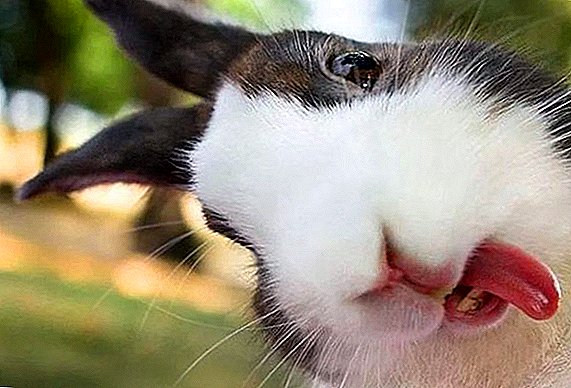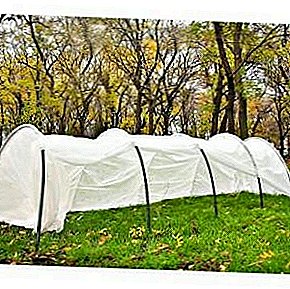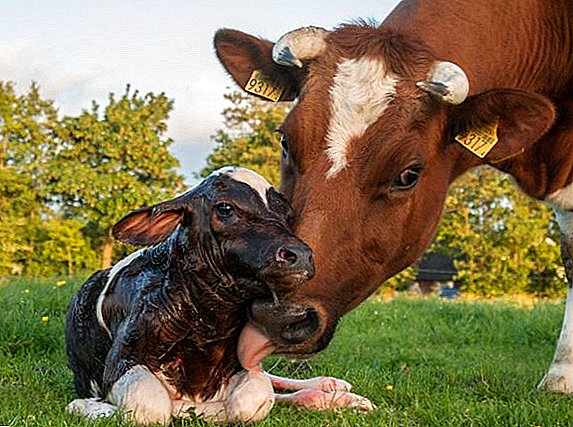 Most of the health problems of cows result from improper maintenance when dry, and also within 40-50 days after calving. It is during this period that the animal has a very high probability of disruption of metabolic processes. As a result, diseases such as ketosis, edema of the udder, placenta retention appear. Another extremely dangerous and widespread problem is postpartum paresis - acute postpartum disorder of the nervous system. How to recognize, cure, and, most importantly, to prevent this condition - let's talk later in the article.
Most of the health problems of cows result from improper maintenance when dry, and also within 40-50 days after calving. It is during this period that the animal has a very high probability of disruption of metabolic processes. As a result, diseases such as ketosis, edema of the udder, placenta retention appear. Another extremely dangerous and widespread problem is postpartum paresis - acute postpartum disorder of the nervous system. How to recognize, cure, and, most importantly, to prevent this condition - let's talk later in the article.
What is postpartum paresis in a cow?
Postpartum paresis is an acute, severe nervous disorder, which manifests itself soon after giving birth to a loss of sensitivity and the paralytic state of the tongue, pharynx, intestine and extremities. Most often occurs in highly productive cows after 5 years, it is also diagnosed in goats, less often in sheep and pigs. 
Risk group and causes
This pathological condition has not yet been fully studied, so experts find it difficult to name the exact causes of paresis. However, based on numerous observations and studies, the following possible causes and predisposing factors were identified:
- the presence in the diet of a large amount of protein feed (concentrates, cereals and legumes);
- large mass of the animal;
- high milk yield;
- calcium deficiency in the body;
- dysfunction of the parathyroid gland;
- excessive exhaustion of the nervous system and stress;
- The age of the animal in the range of 5-8 lactation.
 It is noteworthy that this pathology is extremely rarely diagnosed in outbred cows. Large, fattened animals with signs of obesity are also at risk, especially if their diet includes a lot of concentrated feed and clover.
It is noteworthy that this pathology is extremely rarely diagnosed in outbred cows. Large, fattened animals with signs of obesity are also at risk, especially if their diet includes a lot of concentrated feed and clover.Did you know? A cow named Big Bertha from the UK received two titles at once: the oldest and most prolific cow in the world. Over 49 years of life, she was able to give birth to 39 calves. Burenka was born in 1945.
The chances of developing paresis in animals over 5 years of age, which are at the peak of lactation and reproductive abilities, as well as during long-term stresses (unfavorable conditions of maintenance), and impaired functioning of the endocrine glands, increase. Enhanced exploitation of dairy breeds with an intensive, highly concentrated diet increases the chances of paresis due to increased leaching of calcium from the body. 
Main symptoms
Basically, paresis develops soon after calving - after 4-5 hours, very rarely occurs during childbirth. Paresis can occur in heifers every year at every birth, even if they are relatively quick and easy. The paralytic condition develops in the body with increasing levels of magnesium and phosphorus in the background of reducing the amount of calcium (hypocalcemia).
Find out why the cow does not get up after calving.
Although we said that paresis occurs a few hours after calving, but in fact this pathological process, or rather, its first phases, develop during childbirth:
- Phase I Very short stage (childbirth), which usually goes unnoticed, since all attention is directed to the adoption of the calf. In the first phase, it can be noted that the cow is weakened, she has increased pain sensitivity and excitability, moving slowly with pulling the hind limbs along the ground.
- Phase II It continues for 1-12 hours after the birth of the calf. This phase is characterized by the following symptoms: the animal is weakened, the temperature can be within the normal range or lowered to +37.5 ° С, the peristalsis of the pre-stomachs is disturbed, there is a slight lack of coordination, the animal does not eat, urination and defecation are either absent or frequent, but small portions.
- Phase III At this stage, all the classic manifestations of postpartum paresis already begin: severe weakness, the animal is constantly lying, the neck takes an S-shape, the temperature can drop to +35 ° C, the limbs are cold, pain sensitivity is reduced or absent, constipation, bladder overflow and inability empty, may begin temping (overflow of the scar gases). The breathing of the animal becomes heavy, accompanied by wheezing. When paresis, the milk is either not released at all, or its amount is insignificant, the veins in the udder swell. The unconscious state of the animal progresses, soon leading to a comatose.
Important! Without treatment, the animal may die within a few hours!In extremely rare cases, the symptoms of paresis appear before birth or several months after calving. As a rule, such animals do not respond to therapy and go to a forced slaughter.
 Body position of the cow during paresis Paresis can occur in several forms:
Body position of the cow during paresis Paresis can occur in several forms:- typical: the animal responds well to therapy, the symptoms recede, the cow gradually rises to its feet;
- atypical: the treatment does not give a positive trend, despite the fact that the body is in a physiological norm, the animal is not able to rise to its feet, there may be dislocations, muscle and tendon ruptures when trying, but prolonged lying is also dangerous - bedsores develop;
- subclinical - the female has a reduced appetite and muscle tone of the anterior muscles and smooth muscles, which causes a delay in the placenta and swelling.
How to treat paresis in a cow after calving
Treatment for incomplete paralysis (paresis) should begin immediately in an animal, because its success will depend on it. It is noteworthy that previously there were practically no effective ways of treating females paralyzed after childbirth, but today several methods have been invented to help put the cows on their feet. Next, consider the Schmidt method and the use of drugs for injection. Giving a sick animal something orally is strictly prohibited, since the swallowing process is disturbed at this time and the animal can choke. 
Schmidt method
This method was proposed as early as 1898, and since then postpartum paralysis of cows has ceased to be the main fear of breeders. Despite its simplicity, the method gives amazing results. It consists in forcing air into the viable shares. The essence of the method is that the incoming air begins to irritate the interoreceptors and baroreceptors, which perceive blood pressure.
At the same time, blood pressure stabilizes, the correlation of inhibitory and irritable processes in the central nervous system is improved, the normalization of metabolic processes occurs, the biochemical composition of blood changes (the level of glucose, calcium and phosphorus increases, and the amount of acetone and lactic acid decreases). To implement the method, a simple Evers apparatus is used, consisting of a milk catheter, a rubber bulb, and a connecting rubber tube.  Evers Device Technique:
Evers Device Technique:
- The animal must be laid on its side. If the udder is overfilled, milk should be milked. With a small fullness of the udder do not necessarily. All nipples are cleaned and cleaned with antiseptic or alcohol, with particular attention paid to the tips. The catheter also needs to be sterilized and smeared with petroleum jelly.
- Carefully insert the catheter into the first viable part (the one on which the animal lies) and slowly (!) Begin to inject air. To understand that there is enough air, you can make a special sound, which is obtained by clicking your finger on the udder - the sound is the same as when you click your finger on the inflated cheek.
- After the injection of air into all the lobes, it is necessary to pump up again those of them that were processed first.
- To prevent the air from escaping from the udder, the nipple should be slightly clamped and gently tied with gauze or wide tape for 30-40 minutes. Thread can not be used.
- The animal must be forced to lie on the stomach and bend the hind limbs to create even greater pressure in the udder.
- The sacrum and lumbar area, as well as the chest should be rubbed with active, but neat massage movements. The animal can be warmed in this way: cover it with a thick blanket, warm up the iron well and iron the lumbar region. Then the cow should be wrapped. In no case should not allow drafts in the room with a sick animal.
Important! It is necessary to introduce air into the nipples very slowly, so as not to tear the alveoli and not to damage the parenchyma, otherwise there will be a decrease in productivity. It is also necessary to correctly determine the amount of air, because with insufficient injection of the therapeutic effect will not occur.In some animals, especially well responding to treatment, after 15-20 minutes, there is a positive trend, the animal rises, there is an interest in food. But in most cases, the improvement of the condition occurs within a few hours, while the cow is trembling strongly.
 It is usually enough to do this manipulation with the Evers device once, this is enough for recovery. But some animals may need to repeat the procedure, if the state does not change for the better, after 6-8 hours.
It is usually enough to do this manipulation with the Evers device once, this is enough for recovery. But some animals may need to repeat the procedure, if the state does not change for the better, after 6-8 hours.Intravenous injection
Intravenous injections can be used as a separate method if the method described above is not available, or to combine them for greater efficiency. When paresis, the animal should enter caffeine, calcium and magnesium preparations, glucose, and vitamin D.
Cow calved down - find out what to do next.
It is necessary to make an injection of calcium chloride with glucose in this dosage per cow: 30 ml of calcium, 75 ml of glucose and 300 ml of distillate. You can also use calcium gluconate 20% at a dosage of 5 ml per 10 kg of animal weight or hormones, for example, “ACTH” or “Cortisone” according to the instructions. Intravenous, you can enter the glucose solution 5% in the amount of 2000 ml per individual.  Other actions after forcing air and injections:
Other actions after forcing air and injections:
- 1-2 hours after the cow began to rise to its feet, you need to milk some of the milk. After 3-4 hours, wipe out the rest.
- Not earlier than in 12 hours, it is necessary to give to drink warmed water in the amount of 1 l. After an hour, give another 3 liters, gradually increasing the volume.
- After the release of feces can make an enema.
The advantage of this method is that it never leads to rupture of the alveoli and does not further reduce the milk productivity of the female. Improvement should occur within 1-1.5 hours, if there are no changes, it is necessary to repeat the procedure with the same variable value.
Did you know? To produce 1 kg of oil, you need to process 20 times more milk.
Prevention
One should not rush to reject an animal that once or systematically experiences postpartum paresis. This condition can be successfully prevented by following these rules:
- Be sure to graze the animal, so that it received enough physical activity and insolation.
- It is necessary to strictly monitor the composition of the diet, the presence of all the necessary vitamin-mineral elements in the products.
- Do not allow overfeeding and obesity.
- It is necessary to strictly observe the launch and dry period (60 days before calving).
- If the animal is well-fed, 10 days before the birth and within a week after calving, it is necessary to exclude concentrates from the diet.
- When giving birth, a cow should be in a clean, dry, warm room without drafts.
- After the birth of the calf, the cow needs to be drunk with a bucket of water with the addition of 100-150 g of salt.
- A few weeks before delivery, you can check the level of vitamin D and, if necessary, replenish it with injections or with a diet, since this vitamin is responsible for the absorption of calcium.
- Shortly after giving birth, a mixture of vitamins, minerals, probiotics, electrolytes, and glucose can be soldered to a cow. Such mixtures are sold in veterinary stores.
- Calving is advisable to plan for the summer, as most cases of paresis occur in the winter.
 It is noticed that if the postpartum paresis occurred in the female once, with the following genera, it will most likely recur, so you need to carefully monitor the health of such animals. Provide adequate conditions and food for the burenkas, help them during childbirth, especially if this is the first calving. Careful attention to the animal and the satisfaction of all its necessary needs can prevent many diseases, including paralysis after childbirth.
It is noticed that if the postpartum paresis occurred in the female once, with the following genera, it will most likely recur, so you need to carefully monitor the health of such animals. Provide adequate conditions and food for the burenkas, help them during childbirth, especially if this is the first calving. Careful attention to the animal and the satisfaction of all its necessary needs can prevent many diseases, including paralysis after childbirth.











